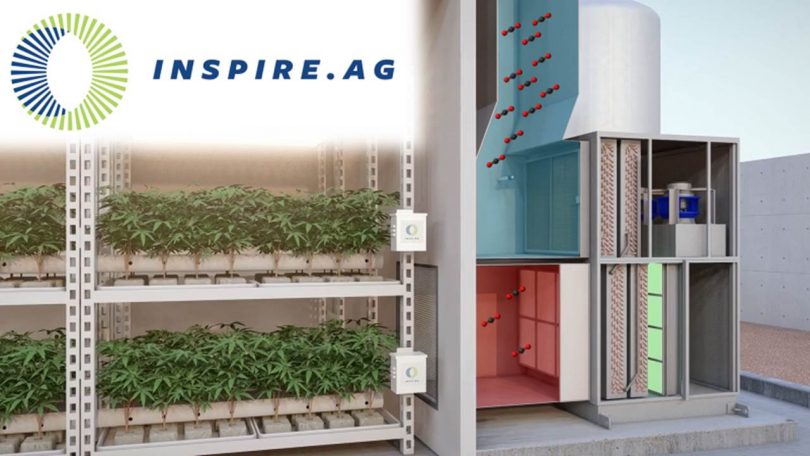Indoor and greenhouse cannabis cultivation offers growers the invaluable chance to play creator, carefully choreographing the environments their crops grow in, and respectively, the unique phenotypes and cultivars these crops grow into. But as we know, with great power comes great responsibility, and in this case, with great responsibility comes a need for comprehensive knowledge that goes beyond cannabis and into subjects like heating, ventilation, and air conditioning (HVAC), construction, architecture, energy efficiency, mechanical, electrical, and plumbing engineering (MEP), and more. Without expertise in these fields, growers can hardly rise to the responsibility of growing cannabis indoors, and all that power to build their very own cannabis world can not only go to waste, but even backfire and cause sweeping losses.
This is where InSpire Transpiration Solutions comes in, a data company with over 25 years of experience in commercial and industrial HVAC systems, more than the last 7 of which they’ve spent learning about cannabis facility design and how to translate their HVAC expertise into this niche. And the key word here is “HVAC expertise,” meaning InSpire fully realizes the boundaries of its domain, and that other components of cannabis facility design that lie beyond it are best left to respective experts who InSpire is happy to refer its clients to at no “finder’s fee.”
“If we think that there is an industry partner that could lend their expertise to a project, we are happy to refer them. We recognize that HVAC is only one part of the successful project equation, and a cross-functional team and expert network raises all the parties to a more successful high water mark,” Robbie Batts, InSpire’s CTO, says.
Such a grounded outlook is a very refreshing change from the “one-stop-“ and “all-things-“ types of companies that are prevalent in the business landscape – an approach that might not be the most suitable for cannabis cultivation.
“I guess the question is: does the industry NEED a one-stop source? For example, a design build contractor knows how to build a building and what resources to assemble to do so. But should they decide what light type to use, or what genetics to source? Regardless, we have yet to see the marriage of facility design/construction and growing-specific fields. It sounds like a great idea, but might not be in practice,” Batts explains.
Before it could be in a position to pick and choose the professionals it refers its clients to, InSpire had to build the expertise it now expects from the members of its exclusive, but well-rounded network. However, that’s easier said than done when the field you’re trying to build expertise in is virtually an uncharted territory. InSpire couldn’t simply subscribe to a YouTube channel or buy a manual to learn the ropes. On the contrary, like scientists seeking the coveted “Eureka!” moment, the company had to go through its fair share of trial and error.
“In the first few years of my involvement with the industry, I was basically “stubbing my toes” (so to speak) by applying commercial equipment where it didn’t belong, and building an understanding of a market that hadn’t been described in any of the standard industry literature,” Batts recalls. “As an engineer, I could design a hospital clean room HVAC system using just the publicly available ASHRAE literature, because it’s been done for decades. But nobody had written anything reliable about the cannabis industry yet.”
In other words, InSpire has paid its dues and has something to show for it.
“Providing consistent airflow at a rate that doesn’t exacerbate transpiration, throttling room setpoints to prevent metabolic stunting of plants, controlling rooms to different temperature and humidity conditions to work best with each lighting type… this is all taken from the experiments we’ve done,” Batts explains.
Despite the industry being in a vastly different stage, so much so that it feels almost like a different industry altogether, InSpire hasn’t lost the hunger for in-depth data and the precious insights locked in it that are deeply rooted in its impressive progress.
“We are a data company. We have an entire division devoted to the curating and analyzing of data from the facilities we are involved in. Every single day we apply the lessons we’ve learned,” Batts explains.
While sometimes, the practice of delving into an endless sea of data can seem overly theoretical and academic, akin to getting 5 PhDs in your subject matter without putting them to work, InSpire doesn’t subscribe to this approach. On the contrary, the company continuously sustains a happy marriage of theory and practice, and cannabis is something like the love child of this marriage – something that’s not always the case in the indoor horticulture industry. Some companies think they can make up for a lack of intimate cannabis knowledge strictly with HVAC expertise.
“We’re never really “finished” with a project. We constantly look for ways to bring the data from a facility back to the operators and tell them, for example: ‘Hey, did you realize that your lights-off temperatures are higher than this genetic prefers? Why don’t you make this adjustment and see if the plants respond positively?’”
This attitude results in very tangible differences.
“By way of example, we recently helped design a storage facility that would have otherwise lost millions of dollars in revenue through THC and terpene degradation,” Batts says.
InSpire has seen the cannabis industry grow before its eyes, following it closely every step of the way. The unequivocal mark of the evolution of both is one that holds true across all industries and the businesses that comprise them:
“Prior to legalization, we let growers dictate what they wanted. But now, we collect and can offer useful data back to them, showing that the temperature and humidity of their grow spaces weren’t actually maintaining the conditions they expected at the canopy level. We give our clients the information, data, and technological tools they need to be successful that weren’t previously available to them.”








